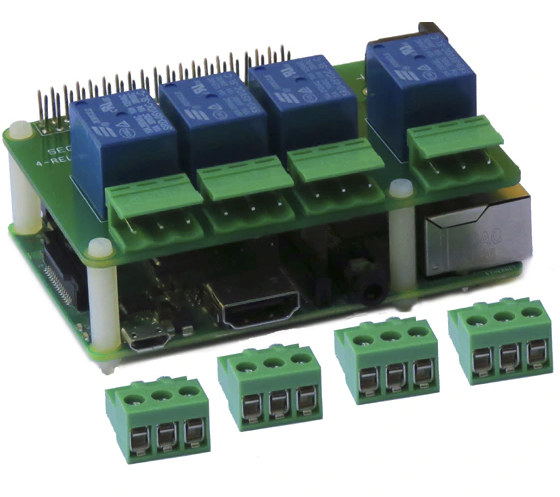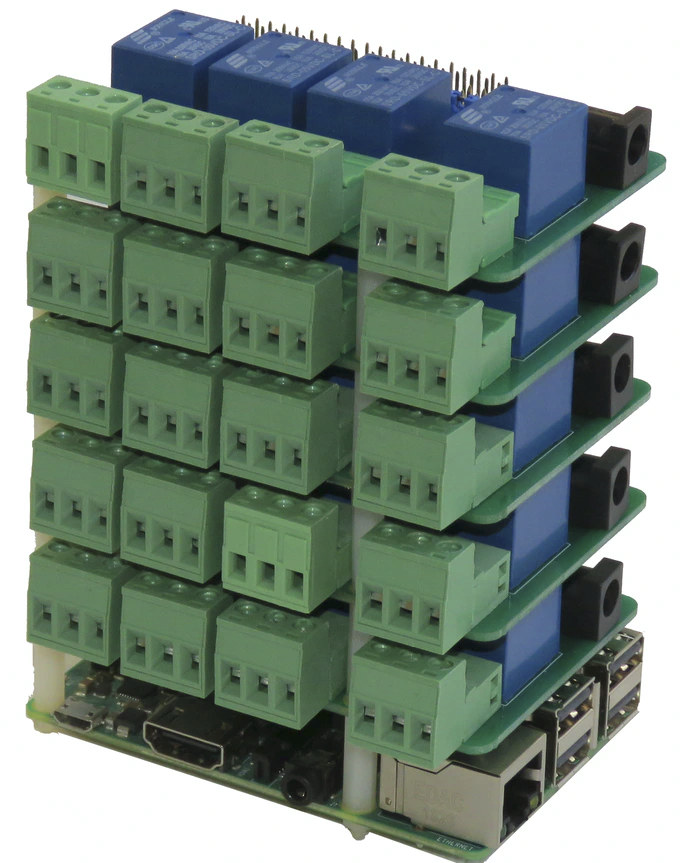People have been playing with off-the-shelf relays on Raspberry Pi boards ever since it was released in 2012, and over the years, some companies have maybe Raspberry Pi-specific relay boards such as Strawberry4Pi and Pi-OT.
Two years ago, Sequent Microsystems introduced a stackable 8-Relay board enabling up to 64 relays to be connected to a single Raspberry Pi board. The 8-relay board only supported 24V/2.5A, and the company is now back on Kickstarter with a 4-relay board with 250V/10A line-switching relays that can offer up to 32 relays by stacking 8 boards connected to one Raspberry Pi board via the 40-pin I/O header.
The board comes with four Songle 250V/10A relays, 3-pin pluggable connectors that accept 18 to 22 AWG wires, and a 5V/3A power supply is recommended. If you stack multiple relay board a beefier power supply may be required. Here are some power consumption numbers provided by the developer:
- All relays OFF: 10 mA @ +5V
- All 4 relays ON: 72 mA each, 298mA in total @ +5V
Communication with the relay board(s) occurs over I2C so you can still use all I/Os from the Raspberry Pi since the 40-pin header is still exposed on the top board. If you stack multiple cards, you’ll need to set jumpers on a 6-pin header to have a different I2C address for each board.

The project has surpassed its lowly $1,000 funding target, and the 4-relay board is offered for $20, and bundles are offered up to an eight board bundle for $120 ($15 per board). Shipping adds $5 to $10 depending on the selected reward, and backers should expect their perk(s) to ship in July 2020.
Via LinuxGizmos

Jean-Luc started CNX Software in 2010 as a part-time endeavor, before quitting his job as a software engineering manager, and starting to write daily news, and reviews full time later in 2011.
Support CNX Software! Donate via cryptocurrencies, become a Patron on Patreon, or purchase goods on Amazon or Aliexpress






I was going to say it’s not possible to screw the wires once the boards are stacked, but this pluggable mechanism is quite smart. I’m still having quite some doubts about the usefulness of 32 relays in a small area, just due to classical issues of power density, either from incoming power plugs or the density of output devices. It might often be easier to have multiple boards at various places in the same room to avoid long cables. But since that’s stackable, it remains “up to 32” and should meet anyone’s expectations.
32 relays would light up the eyes of a good few model railway enthusiasts I have met over the years – they were always looking for better ways to switch point motors or lights. Going from 24v to 250v relays would just allow them to control even more of their environments.
Back in the real world, the real challenge would seem to be having the metalworking skills to build a box with an array of IEC C13 sockets that such a relay stack could control.
There are tons of I2C interfaced relay boards out there already–many of them with proper optoisolation unlike these boards. What do these bring to the table that existing products don’t already? Putting power switching next to the delicate computing equipment is just asking for trouble. Better procedure is to keep them as far apart as possible. Keep the power switching near the load.
Exactly. And not only that. A esp8266 can do that task perfectly. With a port extender (MCP230XX, SX1509, PCF8574) you can quickly control a dotzend of (hopefully proper optoisolated) cheap standard relays. And if you even want to do some fancy ‘on-board’ tasks – even that is a ease with esphome 😉
An talking about prices:
esp8266 ~ $2
Port extender ~ $2
4-Relay board ~ $2
The I2C extenders are optimal for 8 relay boards since all pins can be used. 4 relay boards are not useful building blocks for 8*N relay systems and you need a lot more wires. There are also non-stackable 8-16 relay boards I personally use with RPi Zero when I need 8 to 16 relays.
So I must have been terribly wrong in my past decades as an electrical engineer, when I always expected relays were an adequate means of galvanic isolation. Good now I learnt never forget to protect the relay by an opto coupler…
Only if the optocoupler is itself controlled through an isolation transformer 🙂
Stuff like this gives me the willies. It’s all very well people that have experience messing with the mains on their desk but I’m not sure that the average rpi user should be.
The music choice to go along with the breath taking scene of light bulbs turning on and off was pretty good though.
“…10A and 250V. You can control directly all your lights and appliances.”
“…Pluggable connectors accept 18 to 22 AWG wires”
You won’t be controlling lights and appliances with 18 gauge wire for very long. Those little DuPont wires will act as fuses.
18# is around 8mm2 so more than adequate for lighting even your hairdryer won’t burn an 18#
If you are worried about 18# then see if you find compatible plugs from phoenix, wago etc. accepting 1.5 or 2.5mm2 wiring or up to 10#
My concern would be the pcb traces, and mechanical stability, short circuit protection, etc.
Also they cut a single circuit, which could be problematic sometimes. I was thinking that having a few jumpers on these boards to couple two relays could control the two-circuits on a single command.
@Diego — You may be right, the #18 may not fuse at 2500 watts (250V@10A), but it could easily get hot enough to ignite the insulation and start a fire. #18 lamp wire is rated for 1200 watts, considerably less than 2500. It’s not safe.
Not being very familiar with the AWG metric, I found a chart here which indicates that #18 is not 8mm² but 0.8mm², and given for less than 5A in multi-core, and up to almost 10A on single core (but these ones may not fit well into the connector and the contact may heat there). Note that usually if a square connector accepts a certain diameter for single-core wire, it will accept a slightly larger multi-wire one, so maybe #16 will also fit for ~7A.
https://www.engineeringtoolbox.com/wire-gauges-d_419.html